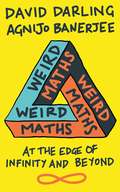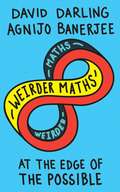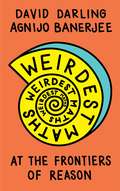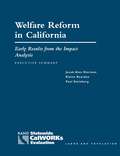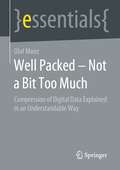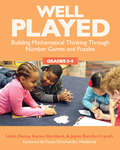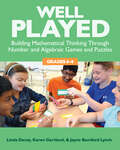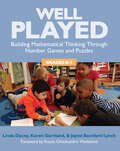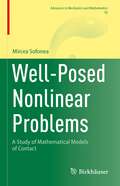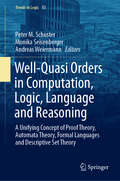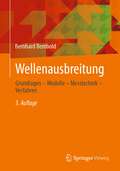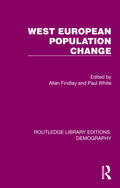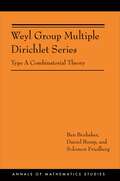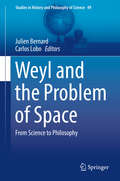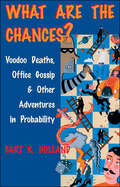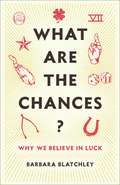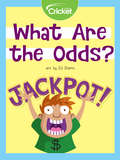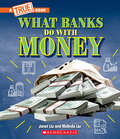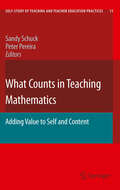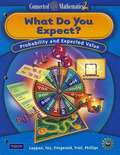- Table View
- List View
Weird Maths: At the Edge of Infinity and Beyond
by David Darling Agnijo BanerjeeIs anything truly random? Does infinity actually exist? Could we ever see into other dimensions? In this delightful journey of discovery, David Darling and extraordinary child prodigy Agnijo Banerjee draw connections between the cutting edge of modern maths and life as we understand it, delving into the strange – would we like alien music? – and venturing out on quests to consider the existence of free will and the fantastical future of quantum computers. Packed with puzzles and paradoxes, mind-bending concepts and surprising solutions, this is for anyone who wants life&’s questions answered – even those you never thought to ask.
Weirder Maths: At the Edge of the Possible
by David Darling Agnijo BanerjeeEven the most enthusiastic of maths students probably at one time wondered when exactly it would all prove useful in &‘real life&’. Well, maths reaches so far and wide through our world that, love it or hate it, we&’re all doing maths almost every minute of every day. David Darling and Agnijo Banerjee go in search of the perfect labyrinth, journey back to the second century in pursuit of &‘bubble maths&’, reveal the weirdest mathematicians in history and transform the bewildering into the beautiful, delighting us once again.
Weirdest Maths: At the Frontiers of Reason
by David Darling Agnijo BanerjeeMaths is everywhere, in everything. It&’s in the finest margins of modern sport. It&’s in the electrical pulses of our hearts and the flight of every bird. It is our key to secret messages, lost languages and perhaps even the shape of the universe of itself. David Darling and Agnijo Banerjee reveal the mathematics at the farthest reaches of our world – from its role in the plots of novels to how animals employ numerical skills to survive. Along the way they explore what makes a genius, why a seemingly simple problem can confound the best and brightest for decades, and what might be the great discovery of the twenty-first century. As Bertrand Russell once said, &‘mathematics, rightly viewed, possesses not only truth, but supreme beauty&’. Banerjee and Darling make sure we see it right again.
Welfare Reform in California
by Donna O. Farley Amy G. Cox Elaine Reardon Joe Hotz Jacob Alex KlermanExamines the effects of the California Work Opportunity and Responsibility to Kids (CalWORKs) program on work activity participation rates of welfare recipients, welfare caseloads, and outcomes for welfare leavers. While the CalWORKs reforms appear to have been responsible for some of the uniform improvement in outcomes shown by the analysis, the robust economy and other policy changes were probably also important.
Well Packed – Not a Bit Too Much: Compression of Digital Data Explained in an Understandable Way (essentials)
by Olaf ManzWith today's flood of data circulating on storage media and the Internet, compression of digital data remains an immensely important aspect of data transmission and storage. This essential explains, without theoretical superstructure and with elementary mathematical methods, the most important compression methods, such as the entropy encodings of Shannon-Fano and of Huffman, as well as the dictionary encodings of the Lempel-Ziv family. Irrelevance reduction and quantization for optical and acoustic signals, which exploit the inadequacies of the human eye and ear for data compression, are also discussed in detail. The whole is illustrated by means of common practical applications from the everyday environment. The presentation allows the use, for example, in working groups at schools, in introductory courses at universities and is also suitable for interested laypersons.This Springer essential is a translation of the original German 1st edition essentials, Gut gepackt – Kein Bit zu viel by Olaf Manz, published by Springer Fachmedien Wiesbaden GmbH, part of Springer Nature in 2020. The translation was done with the help of artificial intelligence (machine translation by the service DeepL.com). A subsequent human revision was done primarily in terms of content, so that the book will read stylistically differently from a conventional translation. Springer Nature works continuously to further the development of tools for the production of books and on the related technologies to support the authors.
Well Played, Grades 3-5: Building Mathematical Thinking Through Number Games and Puzzles
by Linda Dacey Karen Gartland Jayne Bamford LynchStudents love math games and puzzles, but how much are they really learning from the experience? Too often, math games are thought of as just a fun activity or enrichment opportunity. Well Played, Grades 3-5: Building Mathematical Thinking Through Number Games and Puzzles shows you how to make games and puzzles an integral learning component that provides teachers with unique access to student thinking. The twenty-five games and puzzles in Well Played, Grades 3-5 which have all been field-tested in diverse classrooms, contain: Explanations of the mathematical importance of each game or puzzle and how it supports student learning Variations for each game or puzzle to address a range of learning levels and styles Classroom vignettes that model how best to introduce the featured game or puzzle The book also includes a separate chapter with suggestions for how to effectively manage games and puzzles in diverse classrooms; game boards, game cards, and puzzles; assessment ideas; and suggestions for online games, puzzles, and apps. Well Played, Grades 3-5 will help you tap the power of games and puzzles to engage students in sustained and productive mathematical thinking.
Well Played, Grades 6-8: Building Mathematical Thinking Through Number and Algebraic Games and Puzzles
by Linda Dacey Karen Gartland Jayne Bamford LynchStudents love math games and puzzles, but how much are they really learning from the experience? Too often, math games are thought of as just a fun activity or enrichment opportunity. Well Played, Grades 6-8: Building Mathematical Thinking Through Number and Algebraic Games and Puzzles shows you how to make games and puzzles an integral learning component that provides teachers with unique access to student thinking. This third book in the series helps you engage students in grades 6-8 in discussions of mathematical ideas and deepen their conceptual understanding. It also helps you develop students' fluency with number systems; ratio and proportional relationships; expressions and equations, statistics and probability; and patterns, graphs, and functions. The twenty-five games and puzzles in Well Played, Grades 6-8 which have all been field-tested in diverse classrooms, contain: Explanations of the mathematical importance of each game or puzzle and how it supports student learning. Variations for each game or puzzle to address a range of learning levels and styles Classroom vignettes that model how best to introduce the featured game or puzzle. The book also includes a separate chapter with suggestions for how to effectively manage games and puzzles in diverse classrooms; game boards, game cards, and puzzles; assessment ideas; and suggestions for online games, puzzles, and apps. Well Played, Grades 6-8 will help you tap the power of games and puzzles to engage students in sustained and productive mathematical thinking.
Well Played, Grades K-2: Building Mathematical Thinking Through Number Games and Puzzles
by Linda Dacey Karen Gartland Jayne Bamford LynchStudents love math games and puzzles, but how much are they really learning from the experience? Too often, math games are thought of as just a fun activity or enrichment opportunity. Well Played, Grades K-2: Building Mathematical Thinking Through Number Games and Puzzles, shows you how to make games and puzzles an integral learning component that provides teachers with unique access to student thinking. The twenty-five games and puzzles in Well Played, Grades K-2 , which have all been field-tested in diverse classrooms, contain: • Explanations of the mathematical importance of each game or puzzle and how it supports student learning • Variations for each game or puzzle to address a range of learning levels and styles • Classroom vignettes that model how best to introduce the featured game or puzzle The book also includes a separate chapter with suggestions for how to effectively manage games and puzzles in diverse classrooms;game boards, game cards, and puzzles; assessment ideas; and suggestions for online games, puzzles, and apps. Well Played, Grades K-2 will help you tap the power of games and puzzles to engage students in sustained and productive mathematical thinking.
Well-Posed Nonlinear Problems: A Study of Mathematical Models of Contact (Advances in Mechanics and Mathematics #50)
by Mircea SofoneaThis monograph presents an original method to unify the mathematical theories of well-posed problems and contact mechanics. The author uses a new concept called the Tykhonov triple to develop a well-posedness theory in which every convergence result can be interpreted as a well-posedness result. This will be useful for studying a wide class of nonlinear problems, including fixed-point problems, inequality problems, and optimal control problems. Another unique feature of the manuscript is the unitary treatment of mathematical models of contact, for which new variational formulations and convergence results are presented. Well-Posed Nonlinear Problems will be a valuable resource for PhD students and researchers studying contact problems. It will also be accessible to interested researchers in related fields, such as physics, mechanics, engineering, and operations research.
Well-Quasi Orders in Computation, Logic, Language and Reasoning: A Unifying Concept of Proof Theory, Automata Theory, Formal Languages and Descriptive Set Theory (Trends in Logic #53)
by Peter M. Schuster Monika Seisenberger Andreas WeiermannThis book bridges the gaps between logic, mathematics and computer science by delving into the theory of well-quasi orders, also known as wqos. This highly active branch of combinatorics is deeply rooted in and between many fields of mathematics and logic, including proof theory, commutative algebra, braid groups, graph theory, analytic combinatorics, theory of relations, reverse mathematics and subrecursive hierarchies. As a unifying concept for slick finiteness or termination proofs, wqos have been rediscovered in diverse contexts, and proven to be extremely useful in computer science. The book introduces readers to the many facets of, and recent developments in, wqos through chapters contributed by scholars from various fields. As such, it offers a valuable asset for logicians, mathematicians and computer scientists, as well as scholars and students.
Wellenausbreitung: Grundlagen – Modelle – Messtechnik – Verfahren
by Bernhard RemboldDas Lehrbuch vermittelt dem Leser grundlegende Kenntnisse über das, was zwischen Sende- und Empfangsantenne geschieht, da sie für eine plangemäße Funktion entscheidend sind. Die Wellenausbreitung bestimmt maßgebend die Übertragungsverfahren in der Funkkommunikation und beeinflusst in vielen HF-Anwendungen die Systemauslegung. Ziel des Buches ist, dem Leser diese Kenntnisse zu vermitteln sowie ihn in die Lage zu versetzen, Probleme und Möglichkeiten in Zusammenhang mit der Wellenausbreitung zu verstehen und beurteilen zu können.
West European Population Change (Routledge Library Editions: Demography #5)
by Allan FindlayThe 1970s was a decade of significant population change in Western Europe. Originally published in 1986, this book reviews the major trends: fertility decline, counter-urbanisation and the cessation of international labour migration from outside the former EEC. It was the first volume to compare the results of the 1980-82 European census round, and emphasizes the spatial dimension of recent population trends. For countries such as the former West Germany where no census was taken, the difficulties of using registration data are examined. One of the major strengths of the volume is the set of standardised topics which are reviewed by the authors in each country allowing international comparisons to be made from the country case studies. The book concludes with an overview of future trends in European population towards the year 2000.
Weyl Group Multiple Dirichlet Series: Type A Combinatorial Theory (AM-175) (Annals of Mathematics Studies #175)
by Ben Brubaker Daniel Bump Solomon FriedbergWeyl group multiple Dirichlet series are generalizations of the Riemann zeta function. Like the Riemann zeta function, they are Dirichlet series with analytic continuation and functional equations, having applications to analytic number theory. By contrast, these Weyl group multiple Dirichlet series may be functions of several complex variables and their groups of functional equations may be arbitrary finite Weyl groups. Furthermore, their coefficients are multiplicative up to roots of unity, generalizing the notion of Euler products. This book proves foundational results about these series and develops their combinatorics. These interesting functions may be described as Whittaker coefficients of Eisenstein series on metaplectic groups, but this characterization doesn't readily lead to an explicit description of the coefficients. The coefficients may be expressed as sums over Kashiwara crystals, which are combinatorial analogs of characters of irreducible representations of Lie groups. For Cartan Type A, there are two distinguished descriptions, and if these are known to be equal, the analytic properties of the Dirichlet series follow. Proving the equality of the two combinatorial definitions of the Weyl group multiple Dirichlet series requires the comparison of two sums of products of Gauss sums over lattice points in polytopes. Through a series of surprising combinatorial reductions, this is accomplished. The book includes expository material about crystals, deformations of the Weyl character formula, and the Yang-Baxter equation.
Weyl and the Problem of Space: From Science to Philosophy (Studies in History and Philosophy of Science #49)
by Julien Bernard Carlos LoboThis book investigates Hermann Weyl’s work on the problem of space from the early 1920s onwards. It presents new material and opens the philosophical problem of space anew, crossing the disciplines of mathematics, history of science and philosophy. With a Kantian starting point Weyl asks: among all the infinitely many conceivable metrical spaces, which one applies to the physical world? In agreement with general relativity, Weyl acknowledges that the metric can quantitatively vary with the physical situation. Despite this freedom, Weyl “deduces”, with group-theoretical technicalities, that there is only one “kind” of legitimate metric. This construction was then decisive for the development of gauge theories. Nevertheless, the question of the foundations of the metric of physical theories is only a piece of a wider epistemological problem.Contributing authors mark out the double trajectory that goes through Weyl’s texts, from natural science to philosophy and conversely, always through the mediation of mathematics. Readers may trace the philosophical tradition to which Weyl refers and by which he is inspired (Kant, Husserl, Fichte, Leibniz, Becker etc.), and explore the mathematical tradition (Riemann, Helmholtz, Lie, Klein) that permitted Weyl to elaborate and solve his mathematical problem of space. Furthermore, this volume analyzes the role of the interlocutors with whom Weyl discussed the nature of physical space (Einstein, Cartan, De Sitter, Schrödinger, Eddington). This volume features the work of top specialists and will appeal to postgraduates and scholars in philosophy, the history of science, mathematics, or physics.
What Are the Chances?: Voodoo Deaths, Office Gossip, & Other Adventures in Probability
by Bart K. HollandAn &“enjoyable [and] painlessly instructive&” guide to probability, full of examples drawn from daily life and history (The Skeptic). Our lives are governed by chance. But what, exactly, is chance? In this book, statistician and storyteller Bart K. Holland takes us on a tour of the world of probability. Weaving together tales from real life?from the spread of the bubonic plague in medieval Europe and the number of Prussian cavalrymen kicked to death by their horses, through IQ test results and why you have to wait in line for rides at Disney World?Holland captures probability in action, and the everyday events that can profoundly affect our lives but are controlled by just one number. As Holland explains, even chance events are governed by the laws of probability and follow regular patterns called statistical laws. He shows how such laws are successfully applied, with great benefit, in fields as diverse as the insurance industry, the legal system, medical research, aerospace engineering, and climatology. Whether you have only a distant recollection of high school algebra or use differential equations every day, this book offers enlightening and entertaining examples of the impact of chance. &“[An] excellent primer on probability . . . In a time when anecdote and panic seem to influence public policy more than objective analysis, Holland has provided a welcome reminder of the power of the analytical approach.&” —Simon Singh, New Scientist
What Are the Chances?: Voodoo Deaths, Office Gossip, and Other Adventures in Probability
by Bart K. HollandUsing examples drawn from daily life and history, the author explains what probability is and how it works.Our lives are governed by chance. But what, exactly, is chance? In this book, accomplished statistician and storyteller Bart K. Holland takes us on a tour of the world of probability. Weaving together tales from real life—from the spread of the bubonic plague in medieval Europe or the number of Prussian cavalrymen kicked to death by their horses, through IQ test results and deaths by voodoo curse, to why you have to wait in line for rides at Disneyworld—Holland captures the reader's imagination with surprising examples of probability in action, everyday events that can profoundly affect our lives but are controlled by just one number.As Holland explains, even chance events are governed by the laws of probability and follow regular patterns called statistical laws. He shows how such laws are successfully applied, with great benefit, in fields as diverse as the insurance industry, the legal system, medical research, aerospace engineering, and climatology. Whether you have only a distant recollection of high school algebra or use differential equations every day, this book offers examples of the impact of chance that will amuse and astonish.
What Are the Chances?: Why We Believe in Luck
by Barbara BlatchleyMost of us, no matter how rational we think we are, have a lucky charm, a good-luck ritual, or some other custom we follow in the hope that it will lead to a good result. Is the idea of luckiness just a way in which we try to impose order on chaos? Do we live in a world of flukes and coincidences, good and bad breaks, with outcomes as random as a roll of the dice—or can our beliefs help change our luck?What Are the Chances? reveals how psychology and neuroscience explain the significance of the idea of luck. Barbara Blatchley explores how people react to random events in a range of circumstances, examining the evidence that the belief in luck helps us cope with a lack of control. She tells the stories of lucky and unlucky people—who won the lottery multiple times, survived seven brushes with death, or found an apparently cursed Neanderthal mummy—as well as the accidental discoveries that fundamentally changed what we know about the brain. Blatchley considers our frequent misunderstanding of randomness, the history of luckiness in different cultures and religions, the surprising benefits of magical thinking, and many other topics. Offering a new view of how the brain handles the unexpected, What Are the Chances? shows why an arguably irrational belief can—fingers crossed—help us as we struggle with an unpredictable world.
What Are the Odds?
by Liz HuyckProbability and odds are calculated by counting all the times something might happen and then how many times one particular outcome does happen.
What Banks Do with Money: Loans, Interest Rates, Investments... And Much More! (A True Book (Relaunch))
by Janet Liu Melinda LiuA series to build strong financial habits early on in life!Understanding how banks work - as well as the basics of loans and investments - are just two critical financial literacy skills that all kids should have. Did you know that banks use customers' deposits to make loans to other customers? Or that the Federal Reserve is the central bank of the United States? Learn all this and more in What Banks Do with Money - a book that introduces kids to banking.ABOUT THE SERIES:How can I make money? What is inflation? What is the difference between a debit card and a credit card? Economics - and more specifically, money - play such a large role in our lives. Yet there are many mysteries and misconceptions surrounding the basic concepts of finance and smart money management. This set of True Books offers students the know-how they'll need to start on the road to financial literacy-a crucial skill for today's world. Interesting information is presented in a fun, friendly way - and in the simplest terms possible - which will enable students to build strong financial habits early on in life.
What Children Need (The Family and Public Policy #6)
by Jane WaldfogelWhat do children need to grow and develop? And how can their needs be met when parents work? Emphasizing the importance of parental choice, quality of care, and work opportunities, economist Jane Waldfogel guides readers through the maze of social science research evidence to offer comprehensive answers and a vision for change. Drawing on the evidence, Waldfogel proposes a bold new plan to better meet the needs of children in working families, from birth through adolescence, while respecting the core values of choice, quality, and work: ,Allow parents more flexibility to take time off work for family responsibilities; ,Break the link between employment and essential family benefits; ,Give mothers and fathers more options to stay home in the first year of life; ,Improve quality of care from infancy through the preschool years; ,Increase access to high-quality out-of-school programs for school-aged children and teenagers.
What Counts in Teaching Mathematics
by Sandy Schuck Peter PereiraIn this book, internationally recognised scholars and practitioners synthesise current practice and research developments in the area of mathematics teacher education and mathematics education. The book's two sections examine the role and significance of collaborations and critical friends in the self-study of mathematics teaching and teacher education; and the emerging conflicts, dilemmas and incongruities arising from the study of mathematics education practices. The book considers the insights gained from self-analysis regarding the practitioner themselves, as well as their pedagogical content, students and approaches. The contributions highlight the complexity, characteristics and features of mathematics education. The chapters reveal nuances in teaching and learning that are of particular relevance in mathematics education. In addition, the book contains ideas and suggestions on how to enhance the teaching of mathematical content to pre-service teachers. Accordingly, the book appeals to a wide audience of educators--including education academics, teachers, student teachers and researchers. As teacher educators involved in mathematics education, reflection on practice and engagement in practitioner research is becoming increasingly important in our efforts to enhance our teaching. Teachers and student teachers also gain from the insights arising from such reflection. The knowledge and experience encapsulated in this book provides much for the mathematics education community to build on.
What Do You Expect: Probability and Expected Value (Texas)
by Inc. Glenda Lappan James T. Fey William M. Fitzgerald Susan N. Friel Elizabeth Difanis Phillips WestWordsNIMAC-sourced textbook
What Do You Expect? Probability and Expected Value (Connected Mathematics)
by Glenda Lappan James T. Fey Susan N. Friel Elizabeth Difanis PhillipsThe contents of the book include: A First Look at Chance, Experimental and Theoretical Probability, Making Decisions with Probability, Analyzing Compound Events Using an Area Model, Binomial Outcomes, Unit Project, English/Spanish Glossary, etc.
What Do You Expect?, Probability and Expected Value
by Glenda Lappan James T. Fey William M. Fitzgerald Susan N. Friel Elizabeth Difanis PhillipsNIMAC-sourced textbook
What Do You Expect?: Probability and Expected Value
by Glenda Lappan James T. Fey Susan N. Friel Elizabeth Difanis PhillipsNIMAC-sourced textbook
